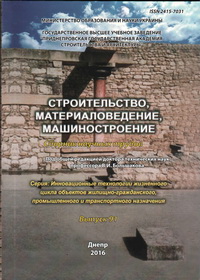Taking into account of joint work frame and flooring in the roofing steel tanks
Keywords:
steel tanks, frame and frameless roof load-bearing structures, flooring, stress, deformation of metal.Abstract
Annotation. The aim of the article is to study the possibility of a significant improvement in technical and economic indicators of fixed roofs steel tanks used for storage of oil and oil products, by taking into account collaborative structures bearing the roof frame with sheet flooring. The relevance of research. With the continuous increase in the cost of steel, any measures that reduce the metal content of constructions without any additional costs of energy and labor resources, seem to be very relevant. Methods: analysis of the stress-strain state of frame and frameless construction of roofs steel tanks, a comparison of the main indicators of frame roofs, calculated with and without working together and supporting the deck frame construction, all calculations are performed using a PC "ANSYS". Results: Quantitative evaluation of the bearing capacity of fixed steel roofs, refined by taking into account the joint work of bearing structures of the roof frame and sheet flooring, produced estimates showing principal possibility and efficacy of frameless roofing for tanks with diameter up to 10-12 m. The practical significance lies in the fact that the results and testing them in a number of real projects, the ability to show a significant (15-20%) reduction of metal roofing stationary steel tanks used for storage of oil and oil products, as well as a significant expansion of the effective use of frameless roofing when regulatory restrictions flooring thickness.References
DBN V 2.2-58.2-94. Vertical steel tanks for oil and petroleum products with vapor pressure of not more than 93.3 kPa / State Committee of Ukraine on oil and gas. - Kyiv, 1994.-p.95.
Chikineva TI Analysis of operational reliability of steel tanks / T.I.Chikineva // Interuniversity coll. "Light building construction" .- Rostov-on-Don: Rostov ICI, 1977, vol. 4.-P. 156-160.
Galyamov A. On the question of individual resource forecasting steel vertical cylindrical tanks /A.K.Galyamov, V.A.Burenin, G.F.Islamgulova // Pipeline transport.-1986.-№7. - P.68-73.
Egorov EA Studies tank designs: main results and prospects /E.A.Egorov // News akademії.-Dnipropetrovs'k: Pdaba, 2000.№12.-S.30-33.
Egorov EA Computational models of "aging" and the economy of operation of enclosing structural elements of sheet structures (for example, steel tanks) / E.A.Egorov // Modern industrial and civil stroitelstvo.-№1.-T.2.-2006-S.43- 49.
Downloads
Published
Issue
Section
License
Редакція Видання категорично засуджує прояви плагіату в статтях та вживає всіх можливих заходів для його недопущення. Плагіат розглядається як форма порушення авторських прав і наукової етики.
При виявлені у статті більш ніж 25% запозиченого тексту без відповідних посилань та використання лапок, стаття кваліфікується як така, що містить плагіат. У цьому випадку стаття більше не розглядається редакцією, а автор отримує перше попередження.
Автори, в статтях яких повторно виявлено плагіат, не зможуть публікуватися в усіх журналах Видавництва ДВНЗ «Придніпровська державна академія будівництва та архітектури».
Автори, які публікуються у цьому журналі, погоджуються з наступними умовами:
- Автори залишають за собою право на авторство своєї роботи та передають журналу право першої публікації цієї роботи на умовах ліцензії Creative Commons Attribution License, котра дозволяє іншим особам вільно розповсюджувати опубліковану роботу з обов'язковим посиланням на авторів оригінальної роботи та першу публікацію роботи у цьому журналі.
- Автори мають право укладати самостійні додаткові угоди щодо неексклюзивного розповсюдження роботи у тому вигляді, в якому вона була опублікована цим журналом (наприклад, розміщувати роботу в електронному сховищі установи або публікувати у складі монографії), за умови збереження посилання на першу публікацію роботи у цьому журналі.
- Політика журналу дозволяє і заохочує розміщення авторами в мережі Інтернет (наприклад, у сховищах установ або на особистих веб-сайтах) рукопису роботи, як до подання цього рукопису до редакції, так і під час його редакційного опрацювання, оскільки це сприяє виникненню продуктивної наукової дискусії та позитивно позначається на оперативності та динаміці цитування опублікованої роботи (див. The Effect of Open Access).

